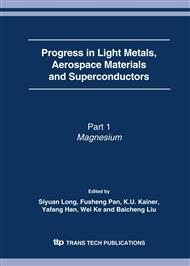p.1881
p.1887
p.1893
p.1897
p.1901
p.1907
p.1913
p.1919
p.1923
Neutron Diffraction Studies of the Zr/Nb Effects on the Nb3Sn Phase Formation of Monofilament Wires
Abstract:
The layer growth of the A15 (Nb3Sn) superconducting phase produced by the internal tin method on model monofilament wires was studied by neutron diffraction and electron microscopy techniques. Different ratios of the inner part of the wire (Sn/Cu) and the effect of the addition of 1% of zirconium to niobium were studied. The high temperature heat treatment plays a key role on the A15 formation and on the cost of the final wires produced. Different temperatures in the range 650-725°C and different annealing times in the range 8-200 hrs have led to the preparation of 72 different samples. The neutron diffraction study has evidenced the different phases formed during the heating treatment and the electron microscopy study has evidenced a power law for the growth rate of the A15 phase. In both studies the addition of zirconium in niobium is very effective on the growth rate of the A15 phase.
Info:
Periodical:
Pages:
1901-1906
Citation:
Online since:
May 2007
Price:
Сopyright:
© 2007 Trans Tech Publications Ltd. All Rights Reserved
Share:
Citation:


